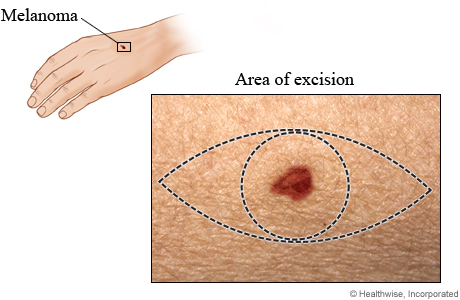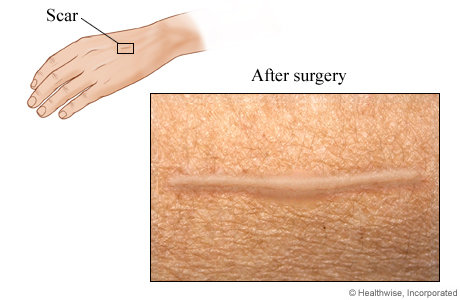Breadcrumb
- Home
- Search Health Topics
- Melanoma Excision Surgery
Melanoma Excision Surgery
Topic Contents
Surgery Overview
Surgery to remove (excise) a melanoma removes the entire melanoma along with a border (margin) of normal-appearing skin. The width of the border of normal skin removed depends on the depth of the melanoma. More tissue, usually skin and fat, is also removed from under the melanoma.
- Small excisions may be closed with stitches and heal without problems.
- Large excisions or those located on the hands, face, or feet may require a skin graft to close the wound after surgery.
The type of anesthetic used for your surgery depends on the size and location of the melanoma. Surgery on small, easily reached melanomas may require only a local anesthetic. Surgery for larger melanomas may require general anesthesia.
How It Is Done


Surgery to remove (excise) melanoma removes the cancer and a border of healthy tissue. In the "Area of excision" picture:
- The inner circle represents the melanoma and healthy tissue that are excised.
- An eye-shaped incision (cut) is often done so that the surgical site can be neatly closed.
If the excision is small, the skin may be closed with stitches after surgery. The "After surgery" picture shows the usual shape of the scar after surgery to remove a small melanoma.
If the excision is large, a skin graft may be needed.
Other ways of removing a melanoma can leave a round scar or a scar shaped a little like the letter "Z."
What To Expect
Recovery after surgery to remove a melanoma depends upon the site and extent of surgery. The wound may take longer to heal if reconstructive surgery techniques such as skin grafts are used.
Why It Is Done
Surgery is the most common treatment for melanoma. Sometimes lymph nodes may be removed at the same time to check them for cancer. Surgery also may be done to remove lymph nodes that have cancer or to remove tumours that may have spread to other parts of the body.
How Well It Works
Surgery to remove the melanoma usually cures melanoma if it is found early. Surgery may cure melanoma if the cancer is only in the nearby lymph nodes.
Surgery may be used to treat metastatic melanoma. This only cures the cancer in a few cases. But surgery may provide the most effective and longest-lasting relief of symptoms.
Risks
Risks of surgery to remove melanoma include:
- Infection.
- Scarring.
- Bleeding.
- Rejection of the skin graft.
Credits
Current as of: March 22, 2023
Author: Healthwise Staff
Medical Review:
Kathleen Romito MD - Family Medicine
Amy McMichael MD - Dermatology
Current as of: March 22, 2023
Author: Healthwise Staff
Medical Review:Kathleen Romito MD - Family Medicine & Amy McMichael MD - Dermatology
This information does not replace the advice of a doctor. Healthwise, Incorporated disclaims any warranty or liability for your use of this information. Your use of this information means that you agree to the Terms of Use and Privacy Policy. Learn how we develop our content.
Healthwise, Healthwise for every health decision, and the Healthwise logo are trademarks of Healthwise, Incorporated.
HealthLinkBC Files
HealthLinkBC Files are easy-to-understand fact sheets on a range of public health and safety topics including disease prevention and immunizations.
Find Services and Resources
If you are looking for health services in your community, you can use the HealthLinkBC Directory to find hospitals, clinics, and other resources.


